Enhance Your Brain Waves
The Power & Mystery of Brain Wave Enhancement
The World’s Happiest Man Is a Tibetan Monk
Matthieu Ricard, a 66-year old Tibetan monk and geneticist, produces brain gamma waves never before reported in neuroscience
Meditating is like lifting weights or exercising for the mind, Ricard told the Daily News. Anyone can be happy by simply training their brain, he says.


According to the pioneering research performed by Dr. James V, Hardt Founder & CEO of Biocybernaut Institute, Nelis went through a synchronization of her brain causing a 360 degree transformation. What normally takes 40 years of training by Zen Master’s, Dr. Hardt worked with Nelis extensively to accelerate this transformation and documented her brain wave changes going through episodes of Alpha, Delta, Theta, and Gama activity using state of the art technology. Dr. Hardt claims that 21 Days is the optimum time needed for the brain to build extensive neural networks adopting the optimal brain wave activity to reach higher states of consciousness. The MediShakti™ 21 Day program is an accelerated program that consists of a three-part process, including an activation.
Benefits of alpha mental state Meditation
- Increase in IQ level
- Increase creativity by 50%
- Better Focus
- Better Decision Making
- Peak Performance
- Depression Relief
- Anxiety Relief
- Fear Resolution
- Angel Management
- Feel more at peace and bliss
- Psychic abilities are enhanced
- Much better sense of sound, color and sight
- Feeling awareness of purification
- More compassionate and empathic
- Slowed down aging
- Become physically stronger
- Become more attractive
- Better wisdom and calmness
- Increased spiritual connection
- Greater experience of the divine light & more…

Brain Waves Definitions
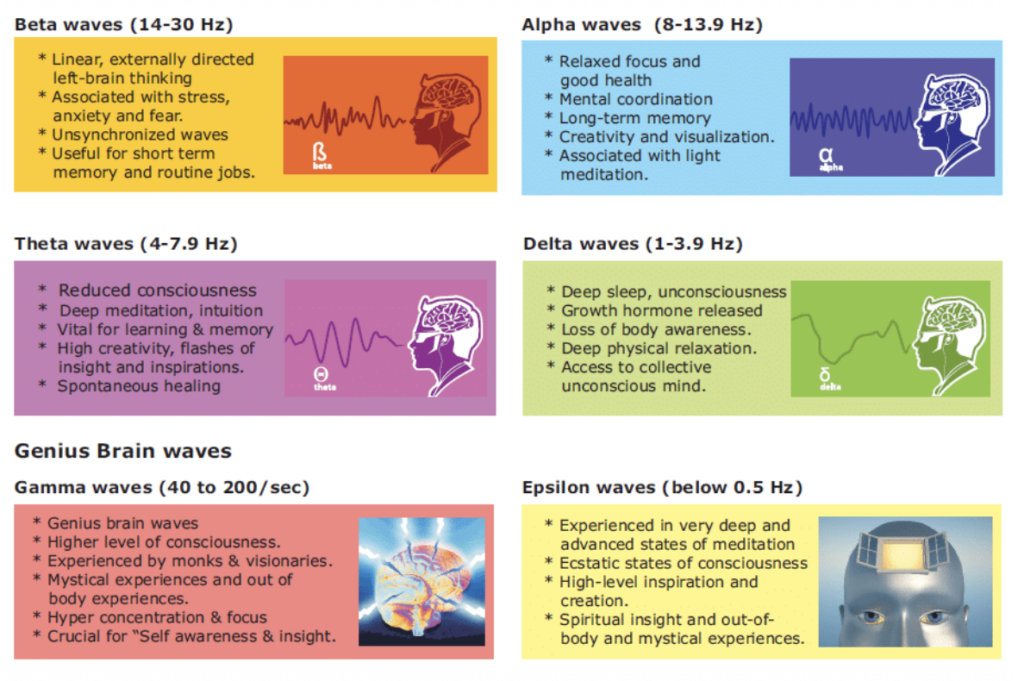
The EEG (electroencephalograph) measures brainwaves of different frequencies within the brain. Electrodes are placed on specific sites on the scalp to detect and record the electrical impulses within the brain. A frequency is the number of times a wave repeats itself within a second. It can be compared to the frequencies that you tune into on your radio. If any of these frequencies are deficient, excessive, or difficult to access, our mental performance can suffer. The raw EEG has usually been described in terms of frequency bands: Gamma greater than 30(Hz) BETA (13-30Hz), ALPHA (8-12 Hz), THETA (4-8 Hz), and DELTA(less than 4 Hz). For example: Our brain uses 13Hz (high alpha or low beta) for “active” intelligence. Often we find individuals who exhibit learning disabilities and attention problems having a deficiency of 13Hz activity in certain brain regions that affects the ability to easily perform sequencing tasks and math calculations.
Brain Wave Frequencies: DELTA (0.1 to 3.5 Hz)
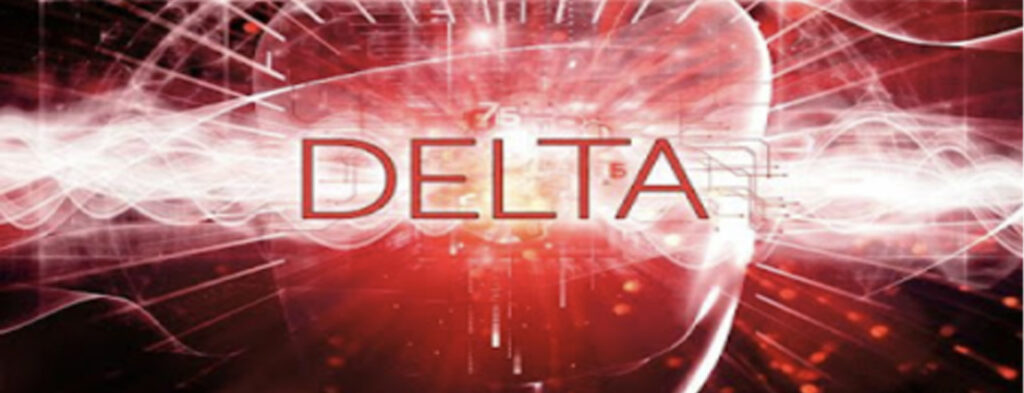
The lowest frequencies are delta. These are less than 4 Hz and occur in deep sleep and in some abnormal processes. It is the dominant rhythm in infants up to one year of age and it is present in stages 3 and 4 of sleep. It tends to be the highest in amplitude and the slowest waves. We increase Delta waves in order to decrease our awareness of the physical world. We also access information in our unconscious mind through Delta. Peak performers decrease Delta waves when high focus and peak performance are required. However, most individuals diagnosed with Attention Deficit Disorder, naturally increase rather than decrease Delta activity when trying to focus. The inappropriate Delta response often severely restricts the ability to focus and maintain attention. It is as if the brain is locked into a perpetual drowsy state. Another way to look at Delta is to imagine you are driving in a car and you shift into 1st gear….you’re not going to get anywhere very fast. So Delta would represent 1st gear.
DELTA (0.1-3 Hz): Distribution: generally broad or diffuse; may be bilateral, widespread
Subjective feeling states: deep, dreamless sleep, non-REM sleep, trance, unconscious
Associated tasks & behaviors: lethargic, not moving, not attentive
Physiological correlates: not moving, low-level of arousal Effects of training: can induce drowsiness, trance, and deeply relaxed states
THETA (4-8 Hz)
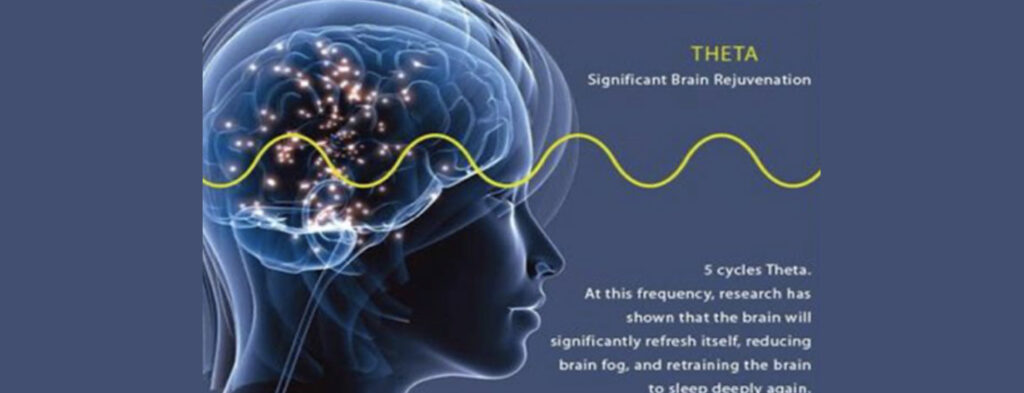
The next brainwave is theta. Theta activity has a frequency of 3.5 to 7.5 Hz and is classed as “slow” activity. It is seen in connection with creativity, intuition, daydreaming, and fantasizing and is a repository for memories, emotions, and sensations. Theta waves are strong during internal focus, meditation, prayer, and spiritual awareness. It reflects the state between wakefulness and sleep and relates to the subconscious mind. It is abnormal in awake adults but is perfectly normal in children up to 13 years old. It is also normal during sleep. Theta is believed to reflect activity from the limbic system and hippocampal regions. Theta is observed in anxiety, behavioral activation and behavioral inhibition. When the theta rhythm appears to function normally it mediates and/or promotes adaptive, complex behaviors such as learning and memory. Under unusual emotional circumstances, such as stress or disease states, there may be an imbalance of three major transmitter systems, which results in aberrant behavior. Back to our car example, Theta would be considered 2nd gear. Not as slow as 1st gear (Delta) but still not very fast.
THETA (3.5-7.5 Hz): Distribution: usually regional, may involve many lobes, can be lateralized or diffuse;
Subjective feeling states: intuitive, creative, recall, fantasy, imagery, creative, dreamlike, switching thoughts, drowsy; “oneness”, “knowing”
Associated tasks & behaviors: creative, intuitive; but may also be distracted, unfocused
Physiological correlates: healing, integration of mind/body
Effects of Training: if enhanced, can induce drifting, trance-like state. If suppressed, can improve concentration, ability to focus attention
ALPHA (8-12 Hz)
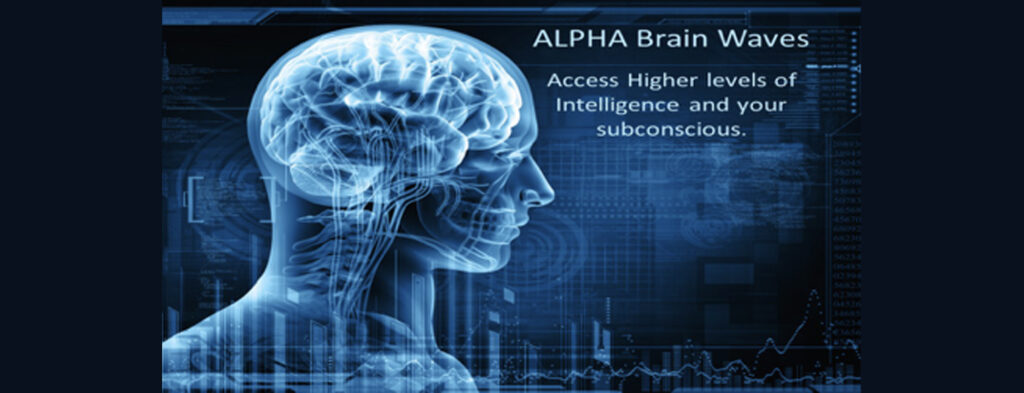
Alpha waves are those between 8 and 12(Hz). Alpha waves will peak around 10Hz. Good healthy alpha production promotes mental resourcefulness, aids in the ability to mentally coordinate, and enhances overall sense of relaxation and fatigue. In this state you can move quickly and efficiently to accomplish whatever task is at hand. When Alpha predominates most people feel at ease and calm. Alpha appears to bridge the conscious to the subconscious. It is the major rhythm seen in normal relaxed adults – it is present during most of life especially beyond the thirteenth year when it dominates the resting tracing. Alpha rhythms are reported to be derived from the white matter of the brain. The white matter can be considered the part of the brain that connects all parts with each other. Alpha is a common state for the brain and occurs whenever a person is alert (it is a marker for alertness and sleep), but not actively processing information. They are strongest over the occipital (back of the head) cortex and also over frontal cortex. Alpha has been linked to extroversion (introverts show less), creativity (creative subjects show alpha when listening and coming to a solution for creative problems), and mental work. When your alpha is within normal ranges we tend to also experience good moods, see the world truthfully, and have a sense of calmness. Alpha is one of the brain’s most important frequency to learn and use information taught in the classroom and on the job. You can increase alpha by closing your eyes or deep breathing or decrease alpha by thinking or calculating. Alpha-Theta training can create an increase in sensation, abstract thinking and self-control. In our car scenario, Alpha would represent neutral or idle. Alpha allows us to shift easily from one task to another.
ALPHA (8-12 Hz): Distribution: regional, usually involves entire lobe; strong occipital w/eyes closed
Subjective feeling states: relaxed, not agitated, but not drowsy; tranquil, conscious
Associated tasks & behaviors: meditation, no action
Physiological correlates: relaxed, healing
Effects of Training: can produce relaxation
Sub band low alpha: 8-10: inner-awareness of self, mind/body integration, balance
Sub band high alpha: 10-12: centering, healing, mind/body connection
BETA (above 12 Hz)
Beta activity is ‘fast’ activity. It has a frequency of 14 and greater Hz. It reflects desynchronized active brain tissue. It is usually seen on both sides in symmetrical distribution and is most evident frontally. It may be absent or reduced in areas of cortical damage.
It is generally regarded as a normal rhythm and is the dominant rhythm in those who are alert or anxious or who have their eyes open.
It is the state that most of brain is in when we have our eyes open and are listening and thinking during analytical problem solving, judgment, decision making, processing information about the world around us.
Beta would represent overdrive or hyperdrive in our car scenario.
The beta band has a relatively large range, and has been divided into low, midrange and high.
LOW BETA (12-15HZ): Distribution: localized by side and by lobe (frontal, occipital, etc)
Subjective feeling states: relaxed yet focused, integrated
Associated tasks & behaviors: low SMR can reflect “ADD”, lack of focused attention
Physiological correlates: is inhibited by motion; restraining body may increase SMR
Effects of Training: increasing SMR can produce relaxed focus, improved attentive abilities,
MID BETA (15-18 Hz): Distribution: localized, over various areas. May be focused on one electrode.
Subjective feeling states: thinking, aware of self & surroundings
Associated tasks & behaviors: mental activity
Physiological correlates: alert, active, but not agitated
Effects of Training: can increase mental ability, focus, and alertness
HIGH BETA (above 18hz): Distribution: localized, may be very focused.
Subjective feeling states: alertness, agitation
Associated tasks & behaviors: mental activity, e.g. math, planning
Physiological correlates: general activation of mind & body functions.
Effects of Training: can induce alertness, but may also produce agitation
GAMMA (above 30 Hz)
GAMMA (above 30hz Hz): Distribution: very localized
Subjective feeling states: thinking; integrated thoughts
Associated tasks & behaviors: high-level information processing, “binding”
Physiological correlates: associated with information-rich task processing
Effects of Training: not known
Gamma is measured between 30 and 44 (Hz) and is the only frequency group found in every part of the brain. When the brain needs to simultaneously process information from different areas, it’s hypothesized that the 40Hz activity consolidates the required areas for simultaneous processing. A good memory is associated with well-regulated and efficient 40Hz activity, whereas a 40Hz deficiency creates learning disabilities
Recommended Books
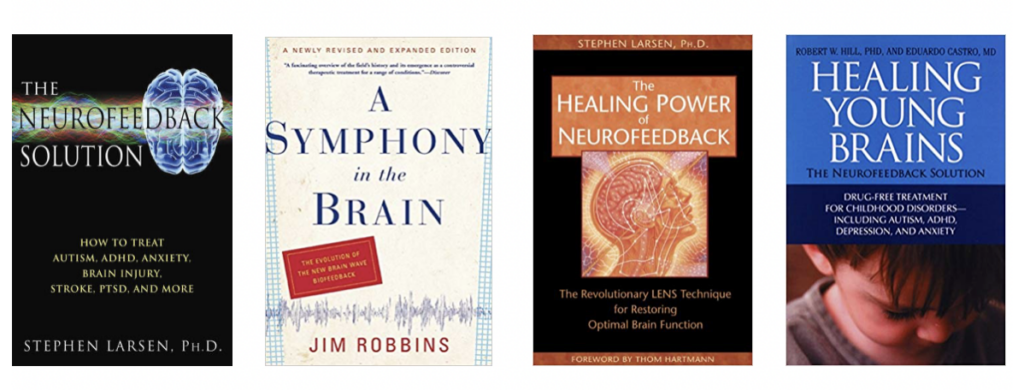
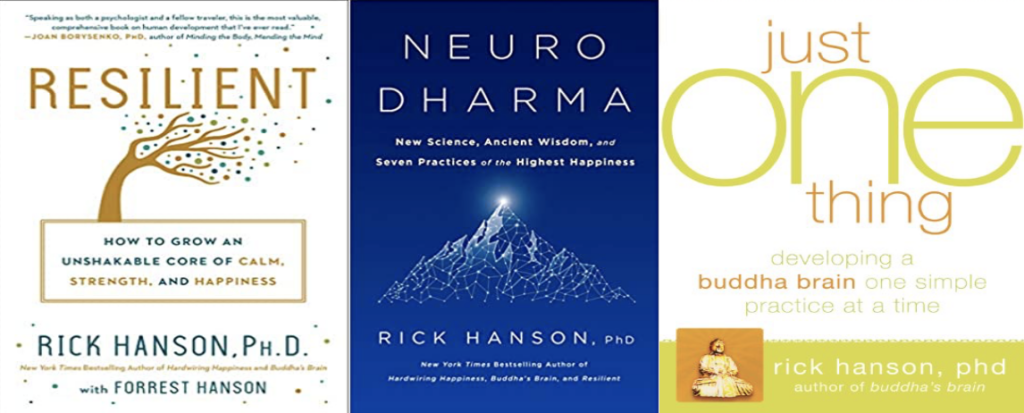
A Neurodharma Perspective – by Rick Hanson, PhD
The Buddha didn’t use an MRI to become enlightened. Many other people have also gone far along their own paths of awakening without advanced technologies. Still, 2,500 years after he walked the dusty roads of northern India, scientists have discovered many things about the body and the brain. The Buddha and others have explored the mental factors of suffering and happiness. During the past couple of decades, we’ve learned a lot about the neural basis of these mental factors. To ignore this emerging understanding seems antithetical both to science and to Buddhism.
The dharma—understanding, peering into the nature of reality—is not specific to Buddhism. The dharma is truth. And the only choice we really have is whether to try to be in relationship with the truth or to live in ignorance. —Rev. Angel Kyodo Williams
When I use the word dharma, I simply mean the truth of things. This is both the way things actually are and accurate descriptions of them. Whatever the truth is, it is not the property of any tradition; it’s for everyone. Neurodharma is the term I use for the truth of the mind grounded in the truth of the body, particularly its nervous system. Neurodharma is of course not Buddhism as a whole. Nor is it necessary for Buddhist (or any other) practice. I just think it can be helpful. We will use this approach to:
explore seven ways of being that are the essence of awakening
learn about their basis in your own brain
Use this understanding to strengthen them in yourself.
Even a little knowledge about your brain can be very useful. It’s a goofy metaphor, but I imagine driving a car and suddenly seeing clouds of steam coming out of the front with red lights flashing on the dashboard and needing to pull over and stop. If I don’t know anything about what the car is made of and how it works, I’m pretty stuck. But if I know about the radiator and the type of fluid it needs to keep the engine cool, then there are things I can do to get back on the road and prevent this in the future. The car is like the body. Thousands of years ago, no one knew much about it. But today we can draw on the knowledge we’ve gained over the centuries about our neural “engine.”
For starters, this knowledge is motivating: when you know that your practices are actually changing your brain, you’re more likely to keep doing them. Really taking your body into account can also draw you into a sense of thankfulness for the physical processes that have led to this moment of consciousness. Understanding what is happening in your brain while experiences are moving through your mind sharpens your mindfulness and fosters insight. You can lighten up about the passing show of consciousness when you recognize that it’s being made by many tiny, swift cellular and molecular processes . . . without any sort of master engineer hiding in the background and continually flipping all the right switches.
In its basic design, we’ve all got the same brain. A neurodharma perspective offers a common framework for understanding the ideas and tools in clinical psychology, personal development (a broad term for other secular approaches), and the wisdom traditions. It can help us prioritize and use key tools we already have. For example, research on the brain’s evolved negativity bias—which we’ll learn more about in chapter 3—highlights the importance of emotionally positive experiences such as gladness and kindness. A greater understanding of the neural “hardware” can even suggest new approaches to our mental “software,” such as neurofeedback. It also helps to individualize practice. When you consider your temperament—perhaps distractible, perhaps anxious—as a perfectly normal variation on the human brain, it’s easier to be self-accepting and to find the practices that are most suited to you.
This approach invites us to work backward from important experiences such as feeling happy and content and explore their basis in the brain. We can know ourselves both subjectively and objectively—from the inside out and from the outside in—and neurodharma is where these two meet. At the same time we can respect what we don’t know and avoid merely intellectual practice. I try to remember the Buddha’s advice to steer clear of the “thicket of views” about theoretical matters, and to focus instead on the practical how of ending suffering and finding true happiness here and now.
Stress Research & Brain Waves

The number of stress victims is growing at an alarming rate with millions of people on stress relief medication. As a result there is much loss of work time and increasing medical expenses with huge financial losses for individuals as well as for companies. The National Institute for Occupational Safety & Health finds that stress-related ailments cost companies in the US about $200 billion a year in increased absenteeism, tardiness, and the loss of talented workers. Between 70% and 90% of employee hospital visits are linked to stress. The epidemic of stress keeps escalating and there is no sign that it is going to stop. Individuals, companies and society at large have to face that fact and do something radical about it. Talking about stress and giving good advices on stress-seminars do not suffice. Stress is not only dependent on the external pressure such as long working hours, many deadlines or a job shift. Most important is it how you handle the stress and how your brain responds to the pressure. Stress occurs when the organism fails to adapt successfully to changes in the environment which confront the individual with new challenges. Most stress occurs when we resist – mentally or emotionally – the new challenges we are faced with.
Resistance, negativity and worried thoughts about situations and persons are what really stresses us. However it is possible to train the brain not to respond habitually and resist new challenges seen as threats. And it is possible to train the individual to go into a flow state without resistance and negative thinking. MediShakti is describes as new groundbreaking method in stress management. (MediShati) is a guide silent meditation with a combination of energy transmission by Nelis Bahder.
Meditation is a very objective method, based on scientific principles and measurements. Brain training with meditation changes the brains neurophysiological and biochemical set up and eventually changes the brain’s responses to stress. The training actually teaches you to control your attention and thinking and to go into flow states without resistance to what is.
Stress and the Autonomic Nervous System. The human brain and nervous system is the most advanced communication system we know of. Each second around the clock this system regulates behavior, thoughts, feelings, organ functions, the blood’s chemical composition, etc. Most of these activities take place automatically without our conscious interference. However in times of stress, the system is upset which may lead to many physical symptoms.
Most of the automatic functions of the body are regulated by the Autonomic Nervous System (ANS). The ANS is divided into a Sympathetic and a Parasympathetic system based partly on anatomical and partly on functional differences. Most organs in the body are stimulated both by sympathetic and parasympathetic nerve fibers. The effects of this stimulation are different and most often antagonistic. The sympathetic system usually facilitates the processes necessary during various behaviors and in dangerous situations where the organism has to prepare for fight or flight.
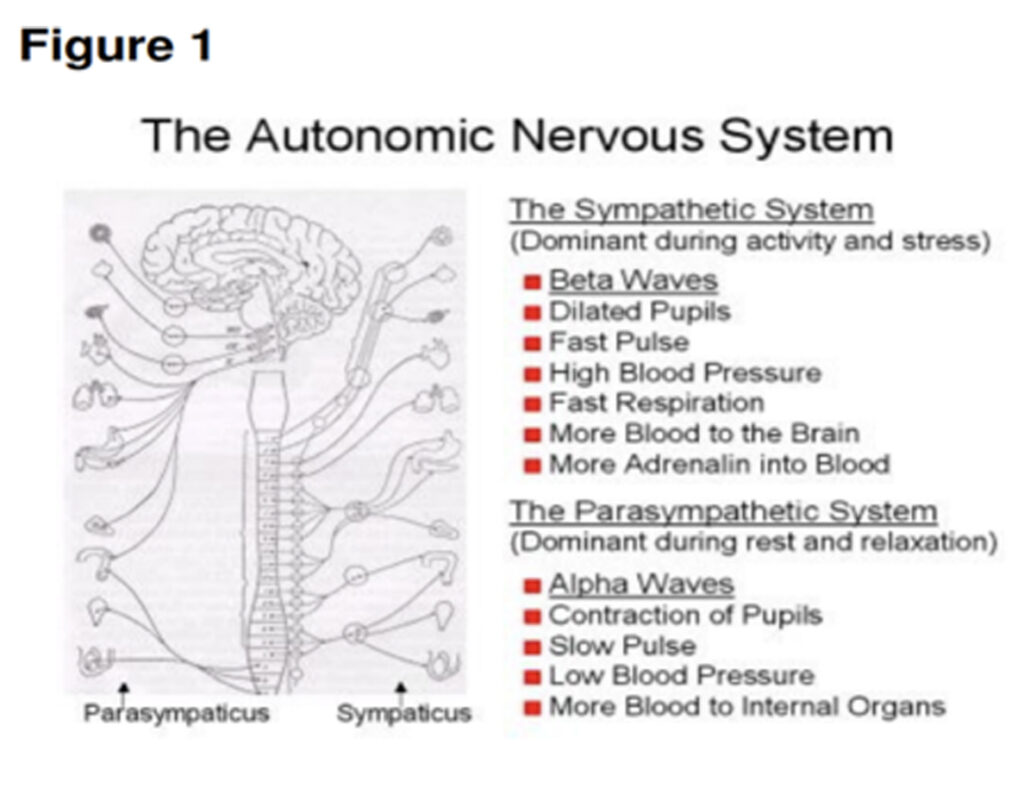
A sudden danger will give rise to an increased sympathetic activity which will result in dilated pupils, increased pulse and blood pressure, faster breathing, higher concentration of blood sugar and an increased blood flow to the brain and the muscles. Since the brain is also activated, the brain wave frequencies will accelerate from slow Alpha and Theta waves to fast Beta frequencies.
The parasympathetic system, on the contrary, will tend to facilitate processes taking place during rest and relaxation. In this case more blood will be directed to the inner organs, the stomach and intestines are stimulated, pulse and blood pressure are lowered and the pupils are constricted. During parasympathetic dominance in the ANS, the brain waves are slowed down from Beta to Alpha wave frequencies and during excessive parasympathetic activity to Theta waves.
In a healthy person without stress there is a fine balance and flexibility in the ANS. When this person is busy and wants to achieve something, his autonomic system is dominated by sympathetic activity and his brain is generating Beta waves. On the other hand, when he comes home after a busy day and relaxes, the balance will change to parasympathetic dominance and his brain will start producing Alpha waves. This is a healthy reaction pattern showing flexibility in the system. However, many people are unable to relax after a hard day’s work. They find it difficult to let go of the stresses and tensions accumulated during the day, and they will still show sympathetic dominance in the ANS. These people often suffer from chronic sympathetic over-activity with a fast pulse, high blood pressure, tense muscles and a restless brain dominated by fast Beta waves. In this case, training the brain to produce more Alpha waves has a beneficial effect on the autonomic balance. It will reduce stress and make the ANS function more properly.
It is obvious that the brain’s activation or arousal level is positively correlated with the EEG frequency. Thus, the faster the brain waves oscillate the more active the brain is and the higher the arousal level. When attention is directed towards the outer world, the brain waves oscillate fast (Beta waves), while they oscillate slowly (Alpha and Theta) when attention is directed towards the inner, mental world. Thus, the brain wave frequency also reflects the direction of attention.
The brain’s response to stress. The brain’s natural response to stress is a decrease of Alpha and an increase in Beta activity (Fig. 2). The higher the stress level, the faster the frequency. Thus, severe stress levels are normally reflected in the baseline EEG by high amplitude Beta 2 frequencies.

Summary and conclusion:
MediSakti could be a promising method for treating the escalating epidemic of stress. Scientific studies have showed the beneficial value of Alpha enhancement training in counteracting stress.
In the 21 Day Program, Nelis will utilize MediShakti™ to guide you through this amazing transcendent meditation. She will help you to awaken your alpha and theta mental state to access higher levels of consciousness unlocking your limitless potential. Click here for more detail.
TESTIMONIALS
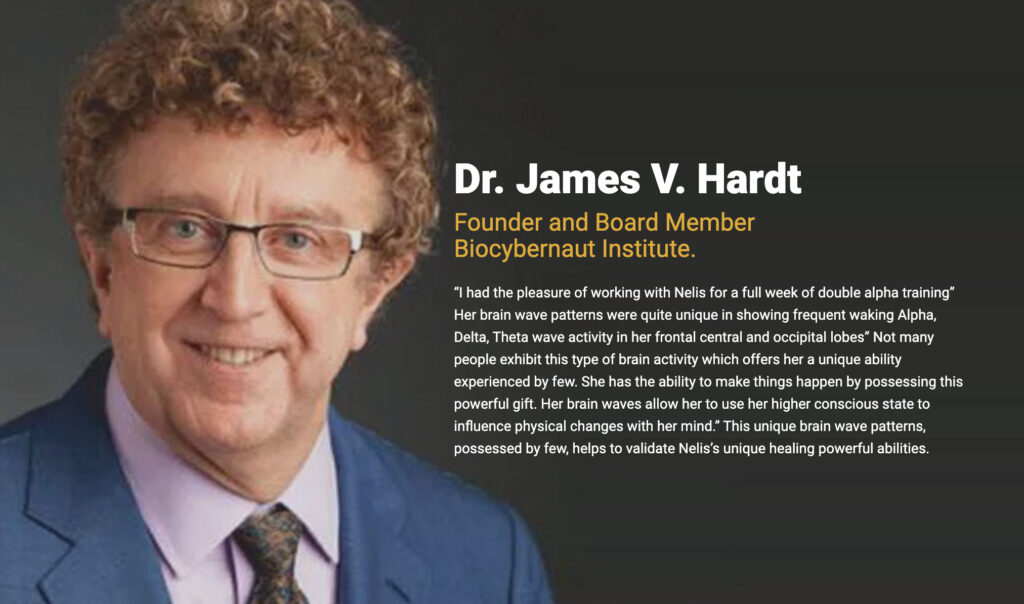
“Group Meditation is a castle that protects the new spiritual aspirants as well as the veteran meditators. Meditating together increases the degree of Self-realization of each member of the group by the law of invisible vibratory exchange of group magnetism”.
~ Paramahansa Yogananda
